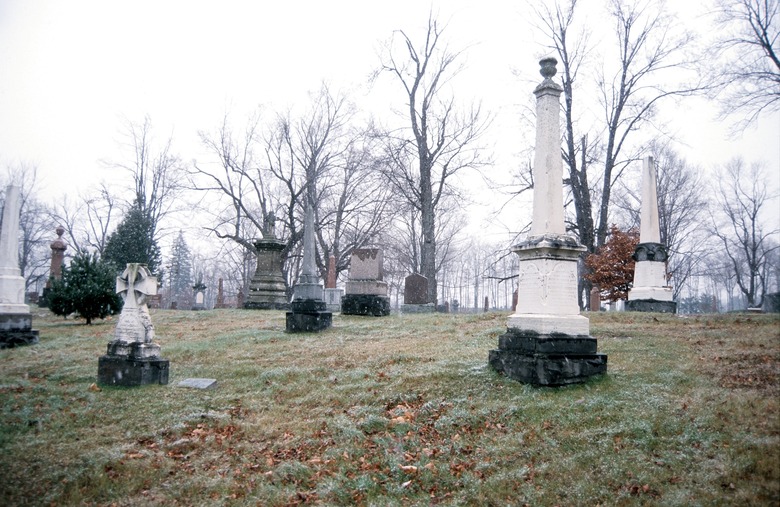The Effects Of Acid Rain On Cemetery Stones
Acid rain has many impacts, including damage to plants and acidification of lakes. The effect of acid rain on cemetery stones is clear enough that it has been used as an indicator of how much acid rain falls in a region. The Geological Society of America asked citizen scientists to record the width of limestone and marble cemetery stones because acid rain dissolves the components of the stone. The research program didn't survive, but the effects of acid rain remain measurable in some cemeteries across the country.
Formation of Acid Rain
Formation of Acid Rain
Acid rain is the result of water vapor reacting with gases such as sulfur dioxide and nitrogen dioxide, forming sulfuric and nitric acids. Sulfur dioxide and nitrogen dioxide are released into the atmosphere through natural processes, such as volcanoes and decomposition, but are also produced by burning fossil fuels. The acidic water vapor then condenses and falls to Earth as acid rain. Acid rain also happens through dry deposition, where the pollutants get stuck in smoke and dust and stick to surfaces, where they react to form acid the next time the surface gets wet.
Geology of Cemetery Stones
Geology of Cemetery Stones
When selecting a rock to memorialize the deceased, there are several considerations. The first is whether it is possible to carve an inscription into the rock; the second is how enduring the rock will be as a monument; third is the aesthetic appeal of the final monument. Available options over the past few centuries are sandstone, limestone, marble, slate and granite. Sandstone and limestone are sedimentary rocks, while marble, slate and granite are harder metamorphic rocks. Limestone and marble are made up of calcium carbonate, making them susceptible to acid rain weathering.
Acid Rain and Calcium Carbonate
Acid Rain and Calcium Carbonate
When rain falls on limestone or marble, a small amount of calcium carbonate dissolves into calcium and carbonate ions. The hydrogen and nitrate or sulfate ions from acid rain react with calcium and carbonate ions. The carbonate atom reacts with water to form bicarbonate, which reacts further with the hydrogen ions from the acid to create water and carbon dioxide gas. The reaction leaves calcium and nitrate or sulfate ions, which wash away. The carbon dioxide is why limestone fizzes when you drop strong acid onto it
Erosion of Cemetery Stones
Erosion of Cemetery Stones
Limestone and marble headstones become weathered because the elements slowly dissolve them. This is a natural process because the calcium carbonate they are made of is slightly soluble in water. Acid rain speeds weathering through its chemical reaction with calcium carbonate. The acid rain, in turn, damages the stone, leaving a rough, pitted surface and making writing and art harder to distinguish. Marble resists acid rain slightly more than limestone because its structure is more densely packed.
References
- Geological Society of America: Gravestones Talking Through Time
- Environmental Protection Agency: What Is Acid Rain?
- Anglican Diocese of Rochester: A Brief Guide to Rock and Stones Types
- Monuments.com: Why Granite is Preferred for Cemetery Monuments
- BBC: Calcium Carbonate
- University of Illinoise at Urbana-Champaign: Limestone and Acid Rain
- U.S. Geologic Survey: How Does Acid Precipitation Affect Marble and Limestone Buildings?
Cite This Article
MLA
Becker, Andrea. "The Effects Of Acid Rain On Cemetery Stones" sciencing.com, https://www.sciencing.com/effects-acid-rain-cemetery-stones-19291/. 24 April 2017.
APA
Becker, Andrea. (2017, April 24). The Effects Of Acid Rain On Cemetery Stones. sciencing.com. Retrieved from https://www.sciencing.com/effects-acid-rain-cemetery-stones-19291/
Chicago
Becker, Andrea. The Effects Of Acid Rain On Cemetery Stones last modified March 24, 2022. https://www.sciencing.com/effects-acid-rain-cemetery-stones-19291/
